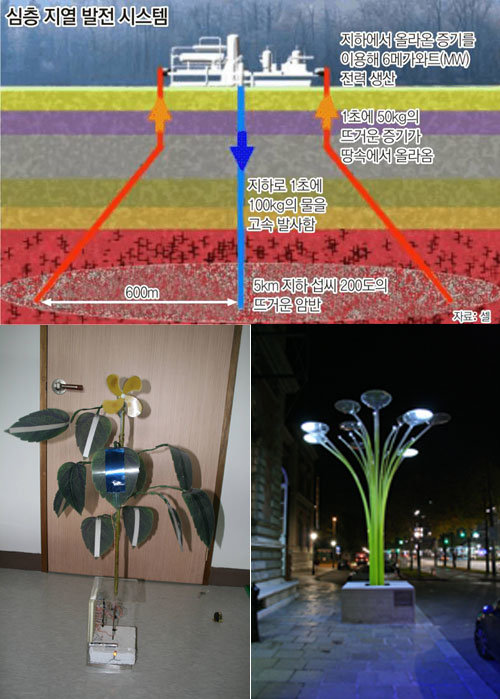Global Search for New Energy Sources Heating Up
Global Search for New Energy Sources Heating Up
Posted August. 29, 2008 10:08,

Inside the lab of energy engineering professor Cheon Wan-gi at Cheju National University is a meter-high tree that generates electricity from the breeze. Because the tree is made of piezoelectric material, it produces electricity when its branches and leaves are struck by wind.
Winds blowing at 1.5 meters per second into this electric tree with 100 leaves can charge an AA battery in five to six hours.
Though the technology is not sufficient now, a material upgrade will significantly reduce charging time, Cheon said. While wind generators only work at wind speeds of seven to 25 meters per second, tree generators are available with a windspeed of four meters per second.
His invention was presented to the seventh International Sustainable Energy Symposium held at the Ritz-Carlton in southern Seoul Sunday.
Scientists worldwide are searching for renewable energy sources, delving into things nobody has thought of. Are massive windmills always necessary to tap wind power? Are wide blue solar panels a must for solar energy? Their thoughts go on and on.
A team of scientists at the University of Southampton in England unveiled an electricity-generating rubber anaconda in the magazine New Scientist. The snake-like rubbery cylinder has both ends sealed. The full-scale version will be seven meters in diameter and 200 meters long, but the prototype was a few meters long.
Passing waves squeeze the rubber snake floating right below the water surface and produce a bulging pressure wave that travels down its length. When the bulge reaches the end, it spins turbines to generate electricity.
A 200-meter-long rubber snake generates electricity enough to power 2,000 households, said team leader John Chaplin. It is more effective and breaks less than existing wave-energy devices.
The British firm Blue H has recently floated wind farms off the coast of Italy. The farms will be located 19 kilometers away off the coast and linked to the land by cables. The company cited lower construction costs and less damage on the environment and ships. They are deep-see generators that make the most of winds blowing on the high seas.
Researchers at Worcester Polytechnic Institute in Massachusetts introduced Aug. 18 a new method for capturing solar energy using heat from paved surfaces. They presented it in a conference organized by the International Society for Asphalt Pavements in Switzerland.
The researchers said an asphalt pavement retains heat after sunset. They buried copper pipes filled with water below the road`s surface to heat the water by the heat in the asphalt. They reversely used the principle of floor heating in using hot water to heat the floor. The key is to use copper pipes having high thermal conductivity.
Color glass used in houses and high rises can capture solar energy to generate electricity. Korean scientists are set to come up with new solar panels that can replace silicon panels. Korea Institute of Science and Technology researchers led by Park Nam-gyu and Korea Advanced Institute of Science and Technology headed by Bae Byeong-soo have developed such panels.
Solar panels made of tinted glass turn sunlight into electricity. Though half as effective as silicon panels, production costs are a fifth of those of silicon panels. In addition, they produce electricity on cloudy days. Even company logos can serve as solar panels, making the entire city a big solar generator.
France, Germany and Australia have dug holes three to five kilometers deep to capture territorial heat of up to 200 degrees Celsius. The amount of energy is far larger than that created by geothermal power generation in Iceland, which uses heat on the surface of the earth.
The process is also interesting. Water is discharged into the holes at high speed. The water hits hot underground rocks, turning into vapor. The vapor rises to the surface and makes turbines spin to generate electricity.
Dr. Song Yun-ho of Korea Institute of Geoscience and Mineral Resources said, The United States plans to tap into underground terrestrial heat to produce energy equivalent to that produced by 100 nuclear power plants by 2050. If successful, the energy issue will be solved with one stroke.
dream@donga.com sunrise@donga.com







